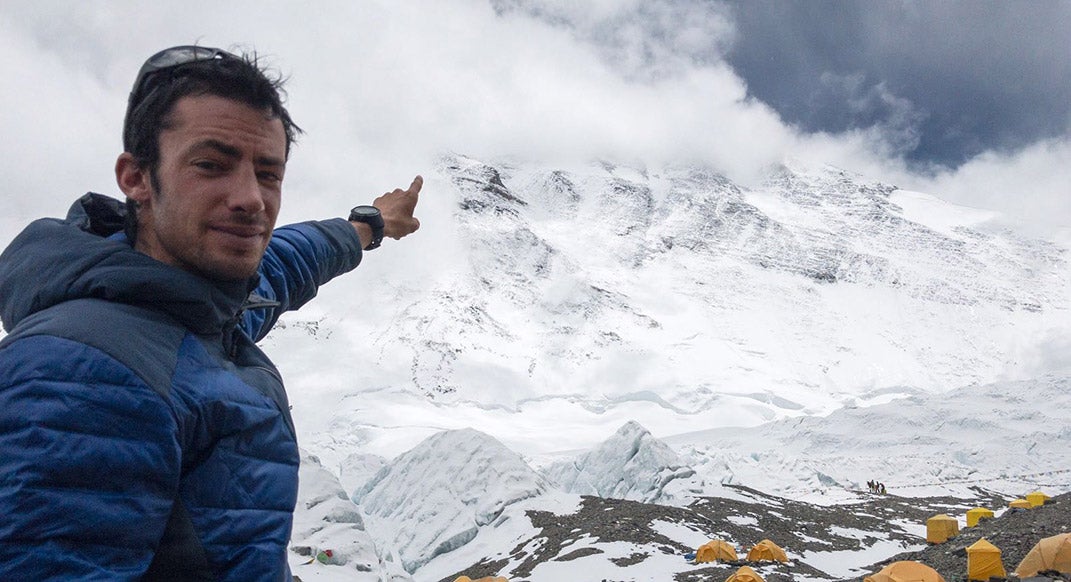Kilian Jornet Summits Everest Twice, But Did He Set a Record?

On Saturday, May 27 Kilian Jornet summited Mount Everest from the North side without the use of supplemental oxygen or fixed ropes—for the second time in a week. The 29-year-old Spaniard began at Advanced Base Camp (6,500 meters) and reached the summit (8,848 meters) after 17 hours. Last Sunday, May 21, he had climbed from Base-Camp (5,100 meters) and reached the summit in 26 hours.
Both ascents are part of Jornet’s Summits of My Life Project—a goal to set speed records (or, fastest-known times) on seven of the world’s most iconic mountains (not to be confused with the Seven Summits) in “alpine style,” meaning in single-push days using as little gear as possible, including no supplemental oxygen and no fixed ropes. The list includes Mont Blanc, the Mont Blanc Traverse and the Matterhorn in the Swiss Alps; Alaska’s Denali; Argentina’s Aconcagua; Russias’s Mount Elbrus and Mount Everest, which sits on the border between Nepal and Tibet. He has achieved all but the last two.
Jornet came to Everest in the hopes of setting a speed record on May 21st. However, stomach issues on the upper portion of the climb slowed his pace. The running and climbing world held its breath as hours went by without word from Jornet, past the hour he was expected to return. In a season that has already seen 10 deaths on Everest, many feared the worst.
But early on May 22nd, reports came through that Jornet was safe back at Advanced Base Camp, having summited at midnight after a long push through stomach cramps and vomiting. With a round-trip speed record already out of the question, Jornet opted to stay at Advanced Base Camp to let his stomach recover.
After recovering from a supposed stomach bug, Jornet decided to give the speed record a second go, yesterday—this time starting from Advanced Base Camp, some 1,300 vertical meters (4,265 feet) higher than Base-Camp, where he started his first attempt last week. He managed to gain the summit considerably faster than the prior attempt, but still shy of a fastest-known time.
The current speed record on this particular route up Everest’s North side—the Northeast Ridge, often referred to as “the normal route”—is 16 hours 42 minutes, set by Austrian Christian Stangl in 2006, also in “pure alpine style.” Stangl bested the previous record of 17 hours, set by Italian ski mountaineer Hans Kammerlander in 1996. Kammerlander also did not use oxygen, but did have Sherpa waiting for him at higher camps with food and drink. Both Stangl and Kammerlander started their ascents from Advanced Base Camp.
According to his website, Jornet is claiming a “new speed record” and a “new fastest-known time” for the May 21 ascent from Base-Camp. However, Jornet’s public relations representatives say that, “There is no evidence of an existing FKT [starting from Base Camp], and [so] we are not talking about breaking records at any time, as there was no record to be broken.”
Indeed, it is nearly impossible to compare Jornet’s May 21st ascent to Stangl and Kammerlander’s ascents, given their different starting points. The May 21st ascent is, in fact, the only known speed attempt via this particular route.
The May 27th ascent is comparable to the previous Northeast Ridge ascents, but it is on par with Kammerlander’s 1996 record—still 18 minutes shy of Stangl’s 2006 record, which is the current time to beat.
More significantly it is important to remember that Jornet’s time—and Stangl and Kammerlander’s—are for the ascent only, not the descent. In alpine climbing of this magnitude, descending can be nearly as hard as—if not harder than—climbing up. As a result, most speed records are only considered for round-trip ascents. All of Jornet’s other Summits of My Life ascents (with the exception of the Mont Blanc Traverse) have been round-trip affairs.
It remains to be seen whether Jornet will count either of these ascent towards his Summits of My Life project, or whether he will return once more to claim an official, round-trip (Base-Camp, to summit, back to Base-Camp) speed record.